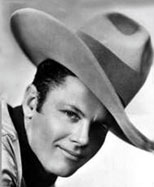 TOM KEENE TOM KEENE
Ratings: Zero to 4 Stars.
DUDE WRANGLER (‘30 Sono Art-World Wide) N/A.
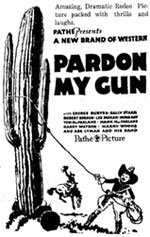 ZERO PARDON MY GUN (‘30 Pathe) Pardon me—but there isn’t a pistol, gun or six-shooter anywhere in sight in this poor excuse in Western garb allowing for Abe Lyman’s (non-Western) swing band, a goofy tap dancer, a kid singer, a flapper, fancy ropers and other assorted vaudeville acts to go through their paces. At this stage, Tom Keene was still too deep in the “aw shucks, gee whiz” cowboy mold and was still known as George Duryea. ZERO PARDON MY GUN (‘30 Pathe) Pardon me—but there isn’t a pistol, gun or six-shooter anywhere in sight in this poor excuse in Western garb allowing for Abe Lyman’s (non-Western) swing band, a goofy tap dancer, a kid singer, a flapper, fancy ropers and other assorted vaudeville acts to go through their paces. At this stage, Tom Keene was still too deep in the “aw shucks, gee whiz” cowboy mold and was still known as George Duryea.
  SUNDOWN TRAIL (‘31 RKO) Keene’s first RKO B- SUNDOWN TRAIL (‘31 RKO) Keene’s first RKO B-
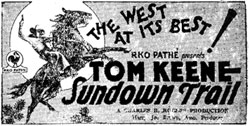 Western has him the foreman of a ranch inherited by an Eastern girl Marion Shilling who is at first disdainful of the West and unappreciative of Tom’s help. An auspicious start, but the best were yet to come. Handled with great care by director Robert F. Hill (who also wrote it) and with inventive photography. Western has him the foreman of a ranch inherited by an Eastern girl Marion Shilling who is at first disdainful of the West and unappreciative of Tom’s help. An auspicious start, but the best were yet to come. Handled with great care by director Robert F. Hill (who also wrote it) and with inventive photography.
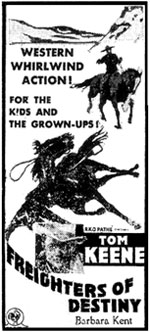   FREIGHTERS OF DESTINY (‘31 RKO) An uneven film from former film editor now first time director Fred Allen (not the comedian) who mixes too much comedy in with his Western adventure to be wholly satisfying. After Keene’s father is killed by raiders, he takes over his Dad’s freighting business and proves to a skeptical town he can handle the job. Unknown to him and storekeeper’s daughter Barbara Kent, banker Mitchell Harris (a weak villain) is head of the raiders (led by Slim Whitaker) and plots to destroy Tom’s wagon caravan so he can take over the lucrative franchise. Talk about your smart movie horses—watch Keene’s Flash undo all the cinches on the horses of the posse! That feat, along with some of the antics of sidekicks Frank Rice (as Rough) and Billy Franey (as Ready—get it?) is where director Allen strayed too far into comedy. It is nice to see a black kid playing and being treated equally with white kids with no jokes or comments being made about it one way or another. It’s just there. Jack Kirk and his trail riding cowboys sing “Old Chisholm Trail” and some other plaintive dirge about the “End of the Trail”. Very nice use of Lone Pine locations! FREIGHTERS OF DESTINY (‘31 RKO) An uneven film from former film editor now first time director Fred Allen (not the comedian) who mixes too much comedy in with his Western adventure to be wholly satisfying. After Keene’s father is killed by raiders, he takes over his Dad’s freighting business and proves to a skeptical town he can handle the job. Unknown to him and storekeeper’s daughter Barbara Kent, banker Mitchell Harris (a weak villain) is head of the raiders (led by Slim Whitaker) and plots to destroy Tom’s wagon caravan so he can take over the lucrative franchise. Talk about your smart movie horses—watch Keene’s Flash undo all the cinches on the horses of the posse! That feat, along with some of the antics of sidekicks Frank Rice (as Rough) and Billy Franey (as Ready—get it?) is where director Allen strayed too far into comedy. It is nice to see a black kid playing and being treated equally with white kids with no jokes or comments being made about it one way or another. It’s just there. Jack Kirk and his trail riding cowboys sing “Old Chisholm Trail” and some other plaintive dirge about the “End of the Trail”. Very nice use of Lone Pine locations!
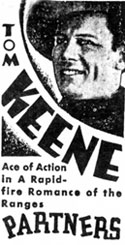  PARTNERS (‘32 RKO Pathe) Off-times too syrupy cowboy-and-the-kid western. Brutish Lee Shumway frames Tom for the murder and robbery of traveling notions-and-trinkets dealer Billy Franey whose death leaves his grandson Bobby Nelson (who becomes way too emotional at times) to be raised by Keene as they become “partners”. Pretty slow stuff, punctuated by two cowboy songs from Jack Kirk. PARTNERS (‘32 RKO Pathe) Off-times too syrupy cowboy-and-the-kid western. Brutish Lee Shumway frames Tom for the murder and robbery of traveling notions-and-trinkets dealer Billy Franey whose death leaves his grandson Bobby Nelson (who becomes way too emotional at times) to be raised by Keene as they become “partners”. Pretty slow stuff, punctuated by two cowboy songs from Jack Kirk.
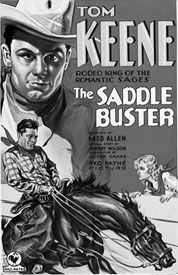   SADDLE BUSTER (‘32 RKO) Scripted by Oliver Drake, well-directed this time by Fred Allen, this rodeo yarn defies the conventional B-western plot of heroes and outlaws. Star rodeo rider Keene goes to work for Fred Burns’ outfit and is cajoled by flirting Marie Quillan, a female rodeo rider, into riding Burns’ most vicious horse. Severely thrown and stomped by the animal, Keene develops a haunting fear of ever breaking horses again. Alone in the mountains, he must confront his inner fears so he may return to the rodeo and once again mount the notorious Wild Fury. SADDLE BUSTER (‘32 RKO) Scripted by Oliver Drake, well-directed this time by Fred Allen, this rodeo yarn defies the conventional B-western plot of heroes and outlaws. Star rodeo rider Keene goes to work for Fred Burns’ outfit and is cajoled by flirting Marie Quillan, a female rodeo rider, into riding Burns’ most vicious horse. Severely thrown and stomped by the animal, Keene develops a haunting fear of ever breaking horses again. Alone in the mountains, he must confront his inner fears so he may return to the rodeo and once again mount the notorious Wild Fury.
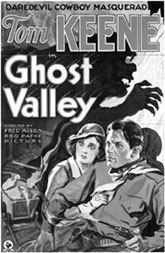     GHOST VALLEY (‘32 RKO) Returning to his hometown after a long absence, Tom is hired by crooked judge Mitchell Harris (who believes Tom to be a drifting cowboy) to impersonate himself in a scheme to convince his adopted father’s niece to sell her share of her dead uncle’s inheritance, a ghost town in the desert which just happens to include an abandoned gold mine. To help persuade her to sell, Harris and his partner hire desert bandits to scare her and her nervous Aunt but Tom masquerades as a mysterious black-caped night rider to catch the outlaws and save he girl. Filled with hard riding and spectacular stunts. This film creates a new hybrid genre—the horror/Western—which spawned others such as “Mystery Ranch”, “Haunted Gold”, “Haunted Ranch”, “Riders of the Whistling Skull”, “Mystery of the Hooded Horsemen”, “Tombstone Canyon”, “Ghost of Hidden Valley”, “Ghost Patrol”, “Whispering Skull”, “Ghost Town Law”—even the “Mystery Mountain” serial. GHOST VALLEY (‘32 RKO) Returning to his hometown after a long absence, Tom is hired by crooked judge Mitchell Harris (who believes Tom to be a drifting cowboy) to impersonate himself in a scheme to convince his adopted father’s niece to sell her share of her dead uncle’s inheritance, a ghost town in the desert which just happens to include an abandoned gold mine. To help persuade her to sell, Harris and his partner hire desert bandits to scare her and her nervous Aunt but Tom masquerades as a mysterious black-caped night rider to catch the outlaws and save he girl. Filled with hard riding and spectacular stunts. This film creates a new hybrid genre—the horror/Western—which spawned others such as “Mystery Ranch”, “Haunted Gold”, “Haunted Ranch”, “Riders of the Whistling Skull”, “Mystery of the Hooded Horsemen”, “Tombstone Canyon”, “Ghost of Hidden Valley”, “Ghost Patrol”, “Whispering Skull”, “Ghost Town Law”—even the “Mystery Mountain” serial.
  BEYOND THE ROCKIES (‘32 RKO) Rustlers! Keene and his fun loving singing/roving buckaroos (Ernie Adams, Julian Rivero and Hank Bell) help Rochelle Hudson and her father keep cattle queen and big rancher Marie Wells and her foreman, Tom London, from rustling their stock. (Songs are obviously performed by Jack Kirk and his pals rather than Keene’s group.) Routine stuff well done. Written by Oliver Drake who reworked the story for “Battling Buckaroo” in ‘34 with Lane Chandler. BEYOND THE ROCKIES (‘32 RKO) Rustlers! Keene and his fun loving singing/roving buckaroos (Ernie Adams, Julian Rivero and Hank Bell) help Rochelle Hudson and her father keep cattle queen and big rancher Marie Wells and her foreman, Tom London, from rustling their stock. (Songs are obviously performed by Jack Kirk and his pals rather than Keene’s group.) Routine stuff well done. Written by Oliver Drake who reworked the story for “Battling Buckaroo” in ‘34 with Lane Chandler.
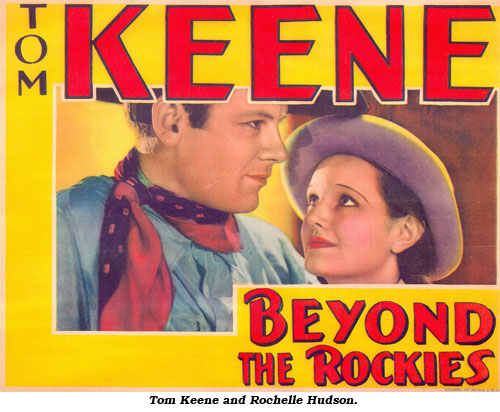
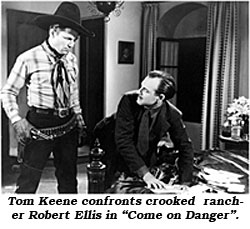     COME ON DANGER (‘32 RKO) One of Keene’s best! This one has it all! Keene’s Texas Ranger brother is killed after being sent on assignment to capture bandit queen Julie Haydon who is wanted for rustling and other crimes. Believing Haydon guilty of his brother’s death, Keene swears revenge. He infiltrates Haydon’s gang, eventually learning—almost too late—that Haydon is only exacting revenge on crooked rancher Robert Ellis for the murder of her father. Ellis and his snakes are laying blame for all their own rustling on Haydon’s head. Stuttering Roscoe Ates is Keene’s sidekick. One of Robert Hill’s best directorial outings, packed with rousing action and thrilling stunts. COME ON DANGER (‘32 RKO) One of Keene’s best! This one has it all! Keene’s Texas Ranger brother is killed after being sent on assignment to capture bandit queen Julie Haydon who is wanted for rustling and other crimes. Believing Haydon guilty of his brother’s death, Keene swears revenge. He infiltrates Haydon’s gang, eventually learning—almost too late—that Haydon is only exacting revenge on crooked rancher Robert Ellis for the murder of her father. Ellis and his snakes are laying blame for all their own rustling on Haydon’s head. Stuttering Roscoe Ates is Keene’s sidekick. One of Robert Hill’s best directorial outings, packed with rousing action and thrilling stunts.
 RENEGADES OF THE WEST (‘32 RKO) All the excitement—a wild fistfight melee and wagon chase—comes at the end of this otherwise quite odd Keene western. The first 45 minutes is filled with a baby contest, a stuttering doctor, a drink/stealing barfly, singing rustlers, light romance with Betty Furness and a humorous and growing friendship and respect between Tom and rustler Rockliffe Fellowes. This was screenwriter Casey Robinson’s only directorial effort…no wonder. The result is dismal. RENEGADES OF THE WEST (‘32 RKO) All the excitement—a wild fistfight melee and wagon chase—comes at the end of this otherwise quite odd Keene western. The first 45 minutes is filled with a baby contest, a stuttering doctor, a drink/stealing barfly, singing rustlers, light romance with Betty Furness and a humorous and growing friendship and respect between Tom and rustler Rockliffe Fellowes. This was screenwriter Casey Robinson’s only directorial effort…no wonder. The result is dismal.
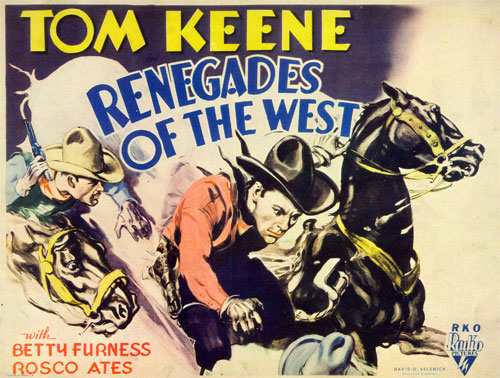
  SCARLET RIVER (‘33 RKO) There’s a whole sub-genre of Westerns about the making of Westerns. These include “Quick Trigger Lee” (‘31) w/Bob Custer. “Mystery Ranch” (‘34) w/Tom Tyler, “Cowboy Star” (‘36) w/Charles Starrett, “The Big Show” (‘36) w/Gene Autry, “It Happened in Hollywood” (‘37) w/Richard Dix, “Hollywood Cowboy” (‘37) w/George O’Brien, “Hollywood Round-Up” (‘37) w/Buck Jones, “Shooting High” (‘40) w/Gene Autry, “Cowboy and the Blonde” (‘41) w/George Montgomery, “Chatterbox” (‘43) w/Joe E. Brown, “Twilight on the Prairie” (‘44) w/Johnny Downs, “Ding Dong Williams” (‘46) w/James Warren, “Out California Way” (‘46) w/Monte Hale, “Under California Stars” (‘48) w/Roy Rogers, “Sons of Adventure” (‘48) w/Russell Hayden, “Kid From Gower Gulch” (‘49) w/Spade Cooley, “Grand Canyon” (‘49) w/Richard Arlen, “Hoedown” (‘50) w/Jock Mahoney, and even a few borderline cases like “Bells of Rosarita”, “Thrill Hunter”, Sioux City Sue” and “Trail of Robin Hood”. But “Scarlet River” is the grand-daddy of them all. Picture begins with comedic overtones as slow-burn director Edgar Kennedy keeps being bothered by encroaching civilization on his Western film landscapes. Keene’s film company goes looking for a real-west location at Scarlet River Ranch and finds more than they bargained for, encountering crooked foreman Lon Chaney Jr. plotting to steal the ranch from Dorothy Wilson by rustling her cattle then having his banker pal foreclose. Features RKO backlot cameos from Joel McCrea, Myrna Loy and Bruce Cabot. Director Otto Brower has Yakima Canutt perform his “under the wagon” stunt. Betty Furness nearly steals the picture as Keene’s sharp-tongued movie-within-a-movie leading lady and frustrated, stuttering, wanna-be screenwriter, ranch hand Roscoe Ates, adds a few moments of laughter, but somehow all the parts never seem to jell and “Scarlet River” never rises above more than just a pleasing hour with a new-found premise. SCARLET RIVER (‘33 RKO) There’s a whole sub-genre of Westerns about the making of Westerns. These include “Quick Trigger Lee” (‘31) w/Bob Custer. “Mystery Ranch” (‘34) w/Tom Tyler, “Cowboy Star” (‘36) w/Charles Starrett, “The Big Show” (‘36) w/Gene Autry, “It Happened in Hollywood” (‘37) w/Richard Dix, “Hollywood Cowboy” (‘37) w/George O’Brien, “Hollywood Round-Up” (‘37) w/Buck Jones, “Shooting High” (‘40) w/Gene Autry, “Cowboy and the Blonde” (‘41) w/George Montgomery, “Chatterbox” (‘43) w/Joe E. Brown, “Twilight on the Prairie” (‘44) w/Johnny Downs, “Ding Dong Williams” (‘46) w/James Warren, “Out California Way” (‘46) w/Monte Hale, “Under California Stars” (‘48) w/Roy Rogers, “Sons of Adventure” (‘48) w/Russell Hayden, “Kid From Gower Gulch” (‘49) w/Spade Cooley, “Grand Canyon” (‘49) w/Richard Arlen, “Hoedown” (‘50) w/Jock Mahoney, and even a few borderline cases like “Bells of Rosarita”, “Thrill Hunter”, Sioux City Sue” and “Trail of Robin Hood”. But “Scarlet River” is the grand-daddy of them all. Picture begins with comedic overtones as slow-burn director Edgar Kennedy keeps being bothered by encroaching civilization on his Western film landscapes. Keene’s film company goes looking for a real-west location at Scarlet River Ranch and finds more than they bargained for, encountering crooked foreman Lon Chaney Jr. plotting to steal the ranch from Dorothy Wilson by rustling her cattle then having his banker pal foreclose. Features RKO backlot cameos from Joel McCrea, Myrna Loy and Bruce Cabot. Director Otto Brower has Yakima Canutt perform his “under the wagon” stunt. Betty Furness nearly steals the picture as Keene’s sharp-tongued movie-within-a-movie leading lady and frustrated, stuttering, wanna-be screenwriter, ranch hand Roscoe Ates, adds a few moments of laughter, but somehow all the parts never seem to jell and “Scarlet River” never rises above more than just a pleasing hour with a new-found premise.
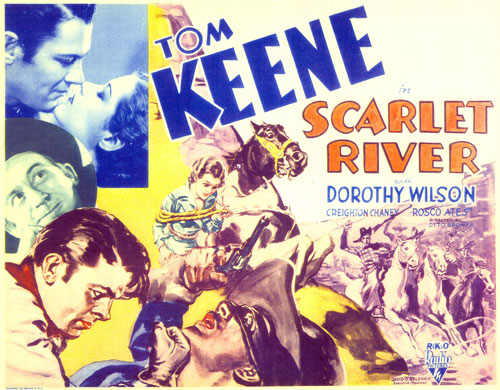
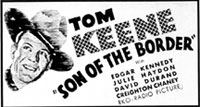     SON OF THE BORDER (‘33 RKO) After rancher Keene is forced to shoot and kill his old friend, Lon Chaney Jr., in a bank robbery, he takes on the responsibility of raising Chaney’s kid brother, David Durand, who’s just arrived from Phoenix and knows nothing of his older brother’s outlawry. Complicating matters is Chaney’s dance hall girlfriend, Julie Haydon, who knows Tom killed Chaney, hates him for it and threatens to expose Tom to Durand. More adult in content, it’s one of Keene’s best. SON OF THE BORDER (‘33 RKO) After rancher Keene is forced to shoot and kill his old friend, Lon Chaney Jr., in a bank robbery, he takes on the responsibility of raising Chaney’s kid brother, David Durand, who’s just arrived from Phoenix and knows nothing of his older brother’s outlawry. Complicating matters is Chaney’s dance hall girlfriend, Julie Haydon, who knows Tom killed Chaney, hates him for it and threatens to expose Tom to Durand. More adult in content, it’s one of Keene’s best.
   CHEYENNE KID (‘33 RKO Radio) A serio-comic misadventure with Keene that would have been perfect for Hoot Gibson. Keene is mistaken for a notorious killer hired by a crooked assayer to help him take over the rich mine owned by Mary Mason and her father. There’s a hell of a fight in the barn at the end. Good story dragged down by Roscoe Ates’ silly gold-making processes. CHEYENNE KID (‘33 RKO Radio) A serio-comic misadventure with Keene that would have been perfect for Hoot Gibson. Keene is mistaken for a notorious killer hired by a crooked assayer to help him take over the rich mine owned by Mary Mason and her father. There’s a hell of a fight in the barn at the end. Good story dragged down by Roscoe Ates’ silly gold-making processes.
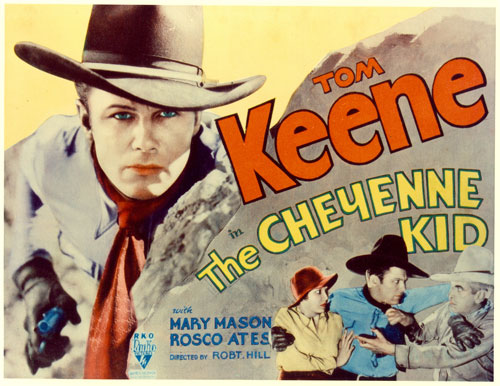
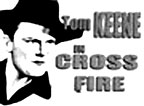
  CROSS FIRE (‘33 RKO) Keene returns home after WWI to find crooked mine owners have outlawed his “over the hill gang” friends. Good blend of cowboys and gangsters. CROSS FIRE (‘33 RKO) Keene returns home after WWI to find crooked mine owners have outlawed his “over the hill gang” friends. Good blend of cowboys and gangsters.
  DRIFT FENCE (‘36 Paramount) Larry “Buster” Crabbe gets top billing, but it’s Tom Keene’s film all the way as he switches identities with Eastern dude Benny Baker who is heir to an Arizona ranch under fire from rustler Stanley Andrews’ gang. Crabbe is a neighboring rancher unfortunately caught up on the wrong side of the drift fence Keene is building—at least until the big shootout at the end. DRIFT FENCE (‘36 Paramount) Larry “Buster” Crabbe gets top billing, but it’s Tom Keene’s film all the way as he switches identities with Eastern dude Benny Baker who is heir to an Arizona ranch under fire from rustler Stanley Andrews’ gang. Crabbe is a neighboring rancher unfortunately caught up on the wrong side of the drift fence Keene is building—at least until the big shootout at the end.
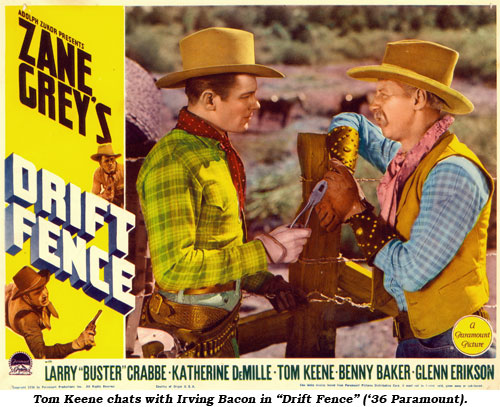
 DESERT GOLD (‘36 Paramount) Zane Grey’s tale of desert greed had been filmed three times before, but this was the only talkie version—and it isn’t good. Monte Blue wants to mine gold on the hidden land in the Superstition Mountains belonging to Indian Chief Buster Crabbe (badly miscast). Blue and his men torture Crabbe trying to make him reveal the whereabouts of the mine. When that doesn’t work, mining engineer Keene (he’s really the star despite the bigger billing of Crabbe) and eastern tenderfoot Robert Cummings are hired by Blue to find the mine. Eventually, with the help of Glenn (Leif) Erickson, Blue’s brother, Keene saves Crabbe and helps the Indians. Problem with the picture lies in the mixture of slapstick comedy and straight Western adventure. The picture manages to generate some real excitement in the last 10 minutes, but it’s too late to overcome the prior foolishness. DESERT GOLD (‘36 Paramount) Zane Grey’s tale of desert greed had been filmed three times before, but this was the only talkie version—and it isn’t good. Monte Blue wants to mine gold on the hidden land in the Superstition Mountains belonging to Indian Chief Buster Crabbe (badly miscast). Blue and his men torture Crabbe trying to make him reveal the whereabouts of the mine. When that doesn’t work, mining engineer Keene (he’s really the star despite the bigger billing of Crabbe) and eastern tenderfoot Robert Cummings are hired by Blue to find the mine. Eventually, with the help of Glenn (Leif) Erickson, Blue’s brother, Keene saves Crabbe and helps the Indians. Problem with the picture lies in the mixture of slapstick comedy and straight Western adventure. The picture manages to generate some real excitement in the last 10 minutes, but it’s too late to overcome the prior foolishness.
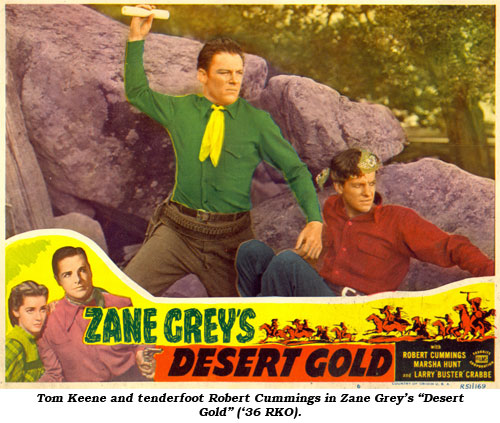
ZERO GLORY TRAIL (‘36 Crescent) First “historical epic” from E. B. Derr’s new Crescent Pictures Corp. to star Keene. At the close of the Civil War, former soldiers headed west to open up new territory. The Bozeman Trail into Sioux Territory is opened and Ft. Phil Kearny in Wyoming is established. It’s here that former Confederate Captain Keene and a Union Lieutenant clash. Redleg renegades lure Union troops away and steal the ammunition wagon which is then recovered by Keene’s men. This, and other action set-pieces all take place off screen and are only discussed until the 57 minute point at which time the “big” Indian battle lasts all of two minutes! Gloming onto Joan Barclay gives the viewer the only interest in this dreary, tedious, overwrought 63 minute melodrama. Derr’s Crescent was off and failing!
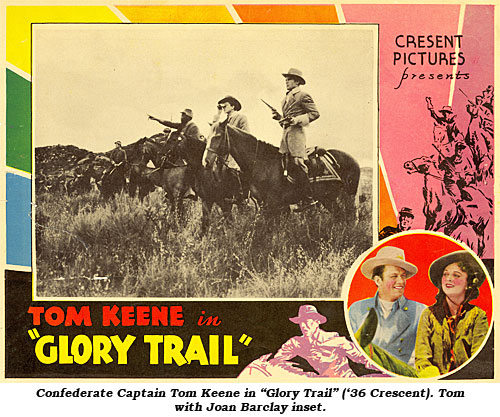
  REBELLION (‘36 Crescent) California was tossed into the lap of the United States at the end of the war with Mexico in 1848. Lawless adventurers seized this opportunity to exploit the lands and adventurers attack the families of Mexican aristocracy and peons made helpless by the utter lack of civil law. At Senorita Rita Cansino’s (later Hayworth) urging that it’s gringos who are looting California and not her brother, Duncan Renaldo, upon whom the real bandits place the blame. Capt. Tom Keene is sent to enforce peace. Better and more “Western” than some of Keene’s Crescent historical dramas, but still not on a par with either of his Monogram series. REBELLION (‘36 Crescent) California was tossed into the lap of the United States at the end of the war with Mexico in 1848. Lawless adventurers seized this opportunity to exploit the lands and adventurers attack the families of Mexican aristocracy and peons made helpless by the utter lack of civil law. At Senorita Rita Cansino’s (later Hayworth) urging that it’s gringos who are looting California and not her brother, Duncan Renaldo, upon whom the real bandits place the blame. Capt. Tom Keene is sent to enforce peace. Better and more “Western” than some of Keene’s Crescent historical dramas, but still not on a par with either of his Monogram series.
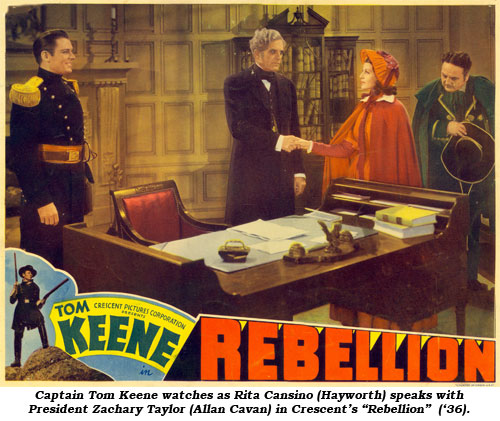
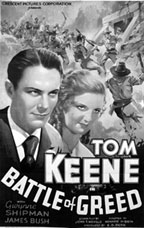  BATTLE OF GREED (‘37 Crescent) Lawyer Keene and a newspaperman help Mark Twain battle the corruption in silver rich Virginia City, NV, circa 1859. However, history tells us Twain didn’t come to Virginia City til 1862! The third of Keene’s historical dramas for Crescent is, as most, tired, listless, talky, actionless affair. BATTLE OF GREED (‘37 Crescent) Lawyer Keene and a newspaperman help Mark Twain battle the corruption in silver rich Virginia City, NV, circa 1859. However, history tells us Twain didn’t come to Virginia City til 1862! The third of Keene’s historical dramas for Crescent is, as most, tired, listless, talky, actionless affair.
ZERO OLD LOUISIANA (‘37 Crescent) It helps to have a historical background on Louisiana/Mississippi events from this period to follow this talkative, sleepy melodrama. Smarmy Robert Fiske, factor of the Louisiana Fur Co., plots to stir up a rebellion among the American settlers so he can become head of the territory, overthrowing the district Governor of upper Louisiana. Fiske sends henchmen to stop respected leader Keene who is on his way to Washington for President Jefferson’s help.
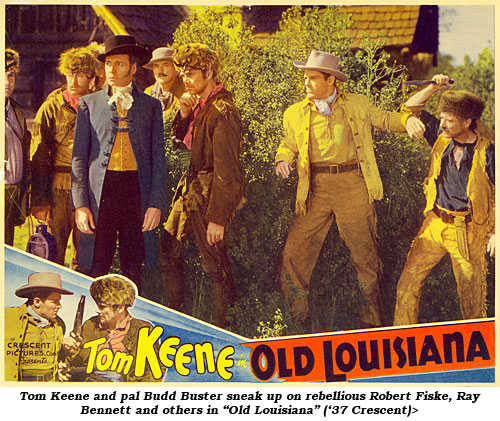
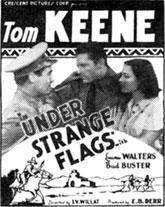 ZERO UNDER STRANGE FLAGS (‘37 Crescent) The Crescent Keene films were promoted as “historical dramas”, but the only true history in any of the fictionalized plots is an actual name or place bantered loosely about with few, if any, historical facts related to the plot. The “story” here has something to do with the Mexican armies of Generals Barranca and Pancho Villa (who is made to act like a complete buffoon) and Keene’s silver mine. Never mind that, after 10 minutes or so you’ll be sound asleep anyway! ZERO UNDER STRANGE FLAGS (‘37 Crescent) The Crescent Keene films were promoted as “historical dramas”, but the only true history in any of the fictionalized plots is an actual name or place bantered loosely about with few, if any, historical facts related to the plot. The “story” here has something to do with the Mexican armies of Generals Barranca and Pancho Villa (who is made to act like a complete buffoon) and Keene’s silver mine. Never mind that, after 10 minutes or so you’ll be sound asleep anyway!
  THE LAW COMMANDS (‘37 Crescent) In 1862, the imminent passing of the Homestead Act, giving all Americans the right to acquire 160 acres of government THE LAW COMMANDS (‘37 Crescent) In 1862, the imminent passing of the Homestead Act, giving all Americans the right to acquire 160 acres of government
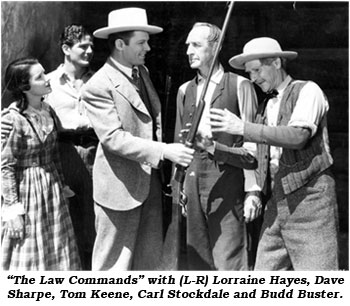 land, started the tide of empire westward. The rich lands of Iowa beckoned, but no sooner had settlers planted their crops when ruthless land sharks made their appearance. Law and order by way of a citizen’s claim association fails when a prominent farmer is gunned down by hoodlums working secretly for respected pillar of the community Robert Fiske. Dr. Tom Keene takes matters into his own hands, seeking assistance from the Governor. Meanwhile, Fiske installs naïve Dave Sharpe as head of a phony protective association in order to trick landowners into deeding over their property to them. More watchable than most of the Keene Crescents. land, started the tide of empire westward. The rich lands of Iowa beckoned, but no sooner had settlers planted their crops when ruthless land sharks made their appearance. Law and order by way of a citizen’s claim association fails when a prominent farmer is gunned down by hoodlums working secretly for respected pillar of the community Robert Fiske. Dr. Tom Keene takes matters into his own hands, seeking assistance from the Governor. Meanwhile, Fiske installs naïve Dave Sharpe as head of a phony protective association in order to trick landowners into deeding over their property to them. More watchable than most of the Keene Crescents.
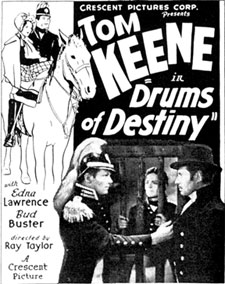  DRUMS OF DESTINY (‘37 Crescent) “In 1815, West Florida was Spanish territory and a hideout for smugglers, renegade whites and savage tribes of marauding Creeks and Seminoles. Armed with contraband rifles, these Indians raided American settlements across the border. General Andrew Jackson established a border patrol of Mississippi volunteer militiamen to protect the pioneers.” With that premise, you’d expect an action-packed historical adventure. Wrong. Capt. Tom Keene and militiamen cross the border into Florida without orders to track down gunrunners. Meanwhile, the gunrunners capture Keene’s brother, Lt. Dave Sharpe, and bring him before the Spanish governor who orders him executed. From there it’s a tepid talkfest as Keene tries to convince the Governor to release Sharpe. DRUMS OF DESTINY (‘37 Crescent) “In 1815, West Florida was Spanish territory and a hideout for smugglers, renegade whites and savage tribes of marauding Creeks and Seminoles. Armed with contraband rifles, these Indians raided American settlements across the border. General Andrew Jackson established a border patrol of Mississippi volunteer militiamen to protect the pioneers.” With that premise, you’d expect an action-packed historical adventure. Wrong. Capt. Tom Keene and militiamen cross the border into Florida without orders to track down gunrunners. Meanwhile, the gunrunners capture Keene’s brother, Lt. Dave Sharpe, and bring him before the Spanish governor who orders him executed. From there it’s a tepid talkfest as Keene tries to convince the Governor to release Sharpe.
  RAW TIMBER (‘37 Crescent) Forest ranger Keene and Washington forestry investigator Raphael (later Ray) Bennett are checking on over-cutting of timber in the Valley of the Moon. Forestry supervisors falsify cutting records and try to pass the blame on to Keene. When Bennett is murdered, the timber thieves again attempt to put the blame on Keene. Best of the Keene Crescent historical adventures—which isn’t saying a great deal. RAW TIMBER (‘37 Crescent) Forest ranger Keene and Washington forestry investigator Raphael (later Ray) Bennett are checking on over-cutting of timber in the Valley of the Moon. Forestry supervisors falsify cutting records and try to pass the blame on to Keene. When Bennett is murdered, the timber thieves again attempt to put the blame on Keene. Best of the Keene Crescent historical adventures—which isn’t saying a great deal.
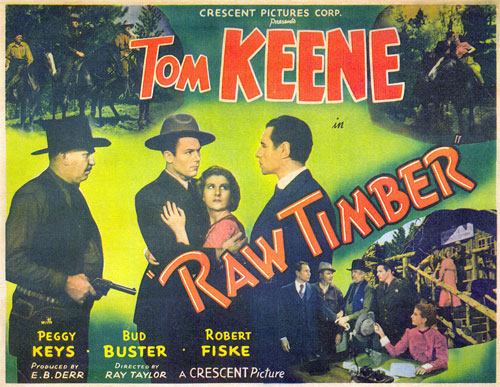
  GOD’S COUNTRY AND THE MAN (‘37 Monogram) Keene’s first film for his initial Monogram series is closer akin to his RKO series (‘30-‘33) than the other three in the series. The theme is actually quite adult in nature. Practically stealing the picture from the rather bland Keene, Charlie King, in one of his best-ever roles, holds up and robs Keene’s storekeeper father, killing him in the process. Fleeing, King brazenly deserts his wife, Betty Compson (also in a standout role). During his revenge-driven search for King, Keene comes to befriend Compson. They luck upon a rich gold strike with the help of a blacksmith and his daughter Charlotte Henry, with whom Tom falls in love. Compson spends her part of the gold-mine profits opening a dance-hall saloon, hoping to lure King there for retribution, which is exactly how things work out. GOD’S COUNTRY AND THE MAN (‘37 Monogram) Keene’s first film for his initial Monogram series is closer akin to his RKO series (‘30-‘33) than the other three in the series. The theme is actually quite adult in nature. Practically stealing the picture from the rather bland Keene, Charlie King, in one of his best-ever roles, holds up and robs Keene’s storekeeper father, killing him in the process. Fleeing, King brazenly deserts his wife, Betty Compson (also in a standout role). During his revenge-driven search for King, Keene comes to befriend Compson. They luck upon a rich gold strike with the help of a blacksmith and his daughter Charlotte Henry, with whom Tom falls in love. Compson spends her part of the gold-mine profits opening a dance-hall saloon, hoping to lure King there for retribution, which is exactly how things work out.
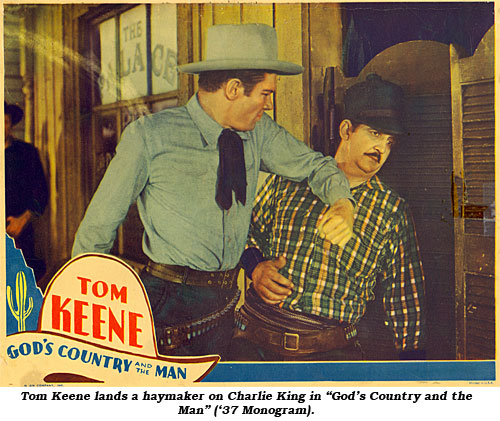
   WHERE TRAILS DIVIDE (‘37 Monogram) It’s brother against brother as lawyer Keene arrives in rough and tumble Rawhide to find kid brother Dave Sharpe under the evil influence of town boss Warner Richmond, dance hall floozy Lorraine Randall (in her best Mae West imitation) and their gang. But when the rest of the God fearing people appoint Keene Sheriff—the law comes to Rawhide! Super effective desert pursuit finale in Red Rock Canyon, CA. One of Keene’s best. It was style that made Keene a larger than life B-Western hero during his Monogram years. That broad confident grin, his sassy self-assured attitude, the backwards gunbelt, the fearless bravado swagger and snap-fire gunplay were all a part of his unlike-any-other-cowboy-star demeanor. WHERE TRAILS DIVIDE (‘37 Monogram) It’s brother against brother as lawyer Keene arrives in rough and tumble Rawhide to find kid brother Dave Sharpe under the evil influence of town boss Warner Richmond, dance hall floozy Lorraine Randall (in her best Mae West imitation) and their gang. But when the rest of the God fearing people appoint Keene Sheriff—the law comes to Rawhide! Super effective desert pursuit finale in Red Rock Canyon, CA. One of Keene’s best. It was style that made Keene a larger than life B-Western hero during his Monogram years. That broad confident grin, his sassy self-assured attitude, the backwards gunbelt, the fearless bravado swagger and snap-fire gunplay were all a part of his unlike-any-other-cowboy-star demeanor.
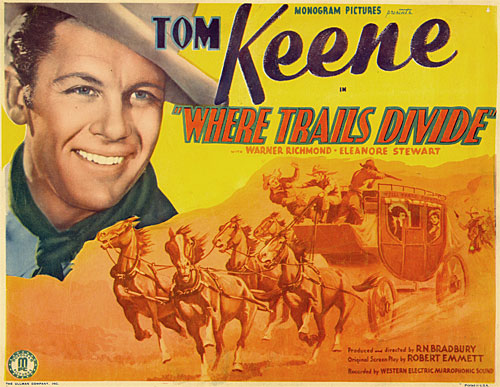
ROMANCE OF THE ROCKIES (‘37 Monogram) N/A.
   PAINTED TRAIL (‘38 Monogram) Rustling, stage holdups and smuggling along the Rio Grande brings U. S. Marshal Keene undercover as the Pecos Kid to the border country where his ruse gains him admittance to the bandit gang headed up by LeRoy Mason and brutish Walter Long. When the daughter of an old friend, Eleanor Stewart, recognizes him it nearly spoils Keene’s plans to work with the Mexican police to round up the border gang. One of Keene’s best. PAINTED TRAIL (‘38 Monogram) Rustling, stage holdups and smuggling along the Rio Grande brings U. S. Marshal Keene undercover as the Pecos Kid to the border country where his ruse gains him admittance to the bandit gang headed up by LeRoy Mason and brutish Walter Long. When the daughter of an old friend, Eleanor Stewart, recognizes him it nearly spoils Keene’s plans to work with the Mexican police to round up the border gang. One of Keene’s best.
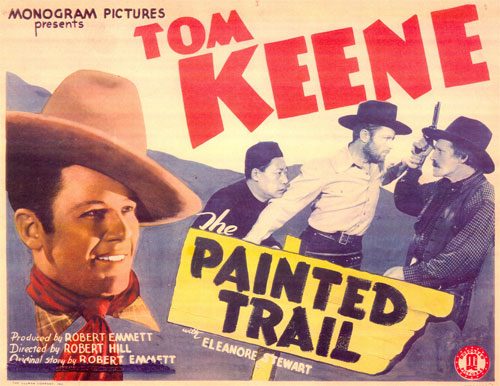
   WANDERERS OF THE WEST (‘41 Monogram) In the first of his second series for Monogram, cattleman Keene searches the west for the rustler/killer of his dad. During his wanderings, he meets Tom Seidel, unaware he is the killer, and becomes friends with him. Seidel learns the truth prior to Keene and involves Tom with a band of rustlers. Inevitably, the showdown must come. Now get this, rustler Stanley Price plans to steal a government buffalo herd, take ‘em to Mexico, breed ‘em with cattle and come up with cattleo. Henchman Gene Alsace turns right to the camera, “I wonder if he’s been drinkin’.” Cheap Bob Tansey written and produced Monogram, but different enough in plot (and weirdness) with a few really good lines to raise it above the norm. With a devaluation of Jack Randall’s Westerns at Monogram, Tom Keene inherited Rusty the Wonder Horse for his series. WANDERERS OF THE WEST (‘41 Monogram) In the first of his second series for Monogram, cattleman Keene searches the west for the rustler/killer of his dad. During his wanderings, he meets Tom Seidel, unaware he is the killer, and becomes friends with him. Seidel learns the truth prior to Keene and involves Tom with a band of rustlers. Inevitably, the showdown must come. Now get this, rustler Stanley Price plans to steal a government buffalo herd, take ‘em to Mexico, breed ‘em with cattle and come up with cattleo. Henchman Gene Alsace turns right to the camera, “I wonder if he’s been drinkin’.” Cheap Bob Tansey written and produced Monogram, but different enough in plot (and weirdness) with a few really good lines to raise it above the norm. With a devaluation of Jack Randall’s Westerns at Monogram, Tom Keene inherited Rusty the Wonder Horse for his series.
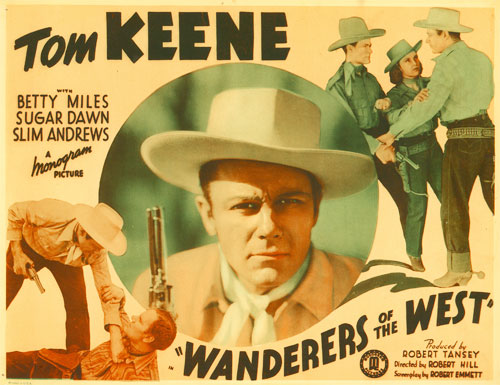
  DYNAMITE CANYON (‘41 Monogram) Nothing original as Stanley Price and Kenne Duncan stir up trouble on the pretense of a cattle/sheep war with their motive to steal Evelyn Finley’s copper-rich ranch. Grin-ning, devil-may-care Keene infiltrates the gang but is discovered by an old crook he once sent to the hoosegow. All the action comes at the end in this tired, overworked plot. “Comedy” elements of Slim Andrews, his mule, bees, and Sugar Dawn teaching him to be a Ranger are totally dis-related to the plot and not funny. Filmed around Prescott, AZ. DYNAMITE CANYON (‘41 Monogram) Nothing original as Stanley Price and Kenne Duncan stir up trouble on the pretense of a cattle/sheep war with their motive to steal Evelyn Finley’s copper-rich ranch. Grin-ning, devil-may-care Keene infiltrates the gang but is discovered by an old crook he once sent to the hoosegow. All the action comes at the end in this tired, overworked plot. “Comedy” elements of Slim Andrews, his mule, bees, and Sugar Dawn teaching him to be a Ranger are totally dis-related to the plot and not funny. Filmed around Prescott, AZ.
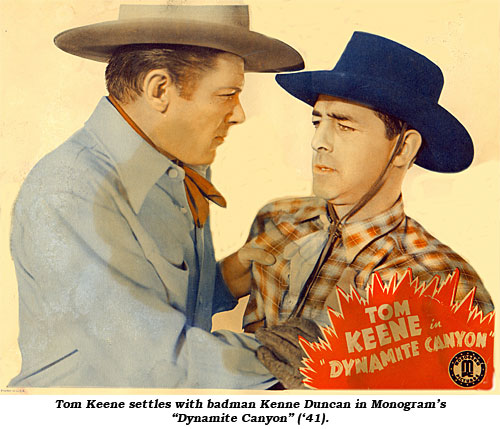
   DRIFTIN’ KID (‘41 Monogram) Nearly every cowboy hero played a dual role at least once and this is the one for Tom as outlaw Stanley Price plans to kill mild-mannered horse rancher (Keene) for his spread and government contract. A federal agent (Keene again) is sent to investigate and discovers he’s a dead ringer for the rancher. One long action sequence gives Betty Miles a chance to really show her stuff—driving a wagon lickity-split, roman-riding the team, a running mount—and more. Tom’s horse, Rusty, earns his wonder horse status. Not only does he toss the rope on Tom’s saddle down a cliff to Tom in the lake below, but Rusty ties the rope to the saddle horn as well, enabling Tom to be pulled up! Maybe it’s not expert film making, but it’s pure B-Western fun all the way! Slim Andrews does his shtick as a firecracker salesman. DRIFTIN’ KID (‘41 Monogram) Nearly every cowboy hero played a dual role at least once and this is the one for Tom as outlaw Stanley Price plans to kill mild-mannered horse rancher (Keene) for his spread and government contract. A federal agent (Keene again) is sent to investigate and discovers he’s a dead ringer for the rancher. One long action sequence gives Betty Miles a chance to really show her stuff—driving a wagon lickity-split, roman-riding the team, a running mount—and more. Tom’s horse, Rusty, earns his wonder horse status. Not only does he toss the rope on Tom’s saddle down a cliff to Tom in the lake below, but Rusty ties the rope to the saddle horn as well, enabling Tom to be pulled up! Maybe it’s not expert film making, but it’s pure B-Western fun all the way! Slim Andrews does his shtick as a firecracker salesman.
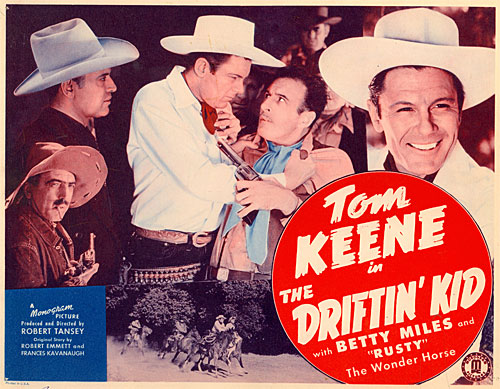
  RIDING THE SUNSET TRAIL (‘41 Monogram) Crooked rancher Kenne Duncan has his men ambush Duncan’s half-brother, rancher Jimmy Aubrey. With Aubrey dead, Duncan inherits Aubrey’s ranch with a forged will—leaving Aubrey’s real heirs, daughters Betty Miles and Sugar Dawn, out in the cold. When Duncan orders the girls off the ranch and takes their cattle, Tom and pal Frank Yaconelli intervene. Soft voiced but tough Betty Miles has a great chase sequence, evading the bad guys. Yaconelli has a lot of really unfunny stuff over bear traps. RIDING THE SUNSET TRAIL (‘41 Monogram) Crooked rancher Kenne Duncan has his men ambush Duncan’s half-brother, rancher Jimmy Aubrey. With Aubrey dead, Duncan inherits Aubrey’s ranch with a forged will—leaving Aubrey’s real heirs, daughters Betty Miles and Sugar Dawn, out in the cold. When Duncan orders the girls off the ranch and takes their cattle, Tom and pal Frank Yaconelli intervene. Soft voiced but tough Betty Miles has a great chase sequence, evading the bad guys. Yaconelli has a lot of really unfunny stuff over bear traps.
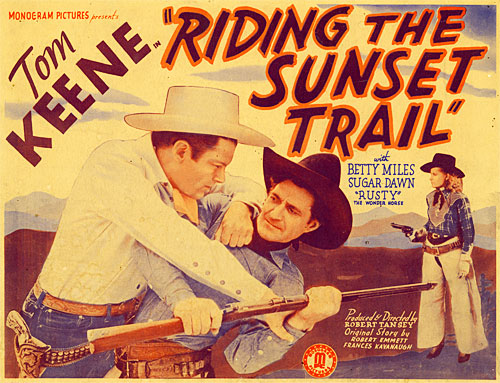
  LONE STAR LAW MEN (‘41 Monogram) When bandits terrorize border towns, the government sends in Marshal Gene Alsace (later Rocky Camron) whom the outlaws bushwhack. Alsace is saved by Keene and saddle-kick Frank Yaconelli. To confuse the crooks Tom has himself appointed a Sheriff who the gang thinks is working with them. Secretly, Tom enlists the aid of expert horsewoman Betty Miles and her sister, pint-sized Sugar Dawn, to round-up the gang. Typical with director Bob Tansey, the windup is an all-over-town gun battle showdown backed by exciting Frank Sanucci music. Production manager Fred Hoose does double duty as he also plays Marshal James in the first scene. There’s one unbelievable scene where Tom, Betty and Sugar ride hell bent for leather to catch Yaconelli on a runaway bicycle. ‘T’ain’t funny McGee! Rusty the Wonder Horse is now replaced by Prince. LONE STAR LAW MEN (‘41 Monogram) When bandits terrorize border towns, the government sends in Marshal Gene Alsace (later Rocky Camron) whom the outlaws bushwhack. Alsace is saved by Keene and saddle-kick Frank Yaconelli. To confuse the crooks Tom has himself appointed a Sheriff who the gang thinks is working with them. Secretly, Tom enlists the aid of expert horsewoman Betty Miles and her sister, pint-sized Sugar Dawn, to round-up the gang. Typical with director Bob Tansey, the windup is an all-over-town gun battle showdown backed by exciting Frank Sanucci music. Production manager Fred Hoose does double duty as he also plays Marshal James in the first scene. There’s one unbelievable scene where Tom, Betty and Sugar ride hell bent for leather to catch Yaconelli on a runaway bicycle. ‘T’ain’t funny McGee! Rusty the Wonder Horse is now replaced by Prince.
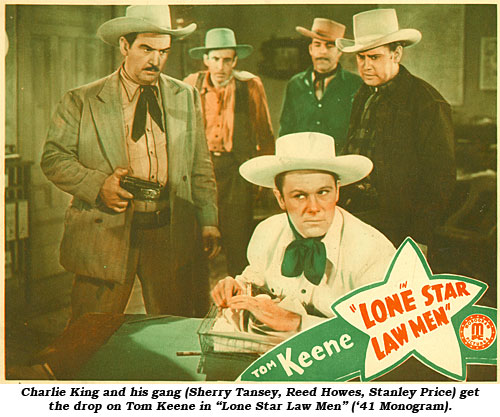
  WESTERN MAIL (‘42 Monogram) Smiling, carefree Keene rides the danger trail to protect Uncle Sam’s mail! I love it when Keene swings into action, gunning down do-badders with that wide “Got him” grin. Banker Leroy Mason ships his bank money by train then has his gun-talent rob the train. Mason gets his money back and collects the insurance as well. Undercover government agents Keene and pal Frank Yaconelli break up their conspiracy. Yaconelli (an acquired taste in sidekicks) sings some silly songs, has a pet monkey in his saddlebag, rides a mule and has another mule following him—for whatever reason! WESTERN MAIL (‘42 Monogram) Smiling, carefree Keene rides the danger trail to protect Uncle Sam’s mail! I love it when Keene swings into action, gunning down do-badders with that wide “Got him” grin. Banker Leroy Mason ships his bank money by train then has his gun-talent rob the train. Mason gets his money back and collects the insurance as well. Undercover government agents Keene and pal Frank Yaconelli break up their conspiracy. Yaconelli (an acquired taste in sidekicks) sings some silly songs, has a pet monkey in his saddlebag, rides a mule and has another mule following him—for whatever reason!
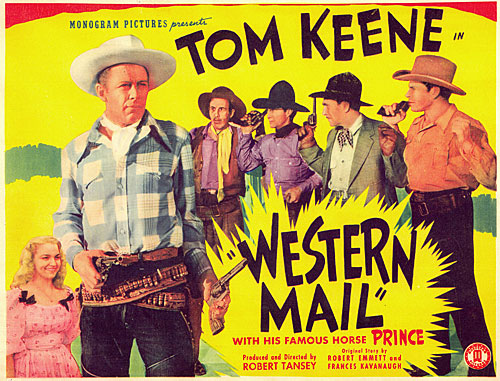
 ARIZONA ROUNDUP (‘42 Monogram) The earlier ‘37-‘38 Keene Monograms were pretty good, showing the able directorial work of Robert North Bradbury and Robert Hill. But when Bob Tansey took over production reins in ‘41 the quality began to suffer until, by “Arizona Roundup”, there was barely a semblance of a movie. On top of his loose continuity, Tansey added Frank Yaconelli as Keene’s sidekick—first as a Mexican (Lopez Mendoza), then as French Canadian Pierre. Whichever, Yaconelli is way over the top with Keene, resulting in the most unfunny sidekick in B-Western history. Here, Yaconelli and Nick Moro engage in an abhorrent “musical interlude” time filler that makes Smiley Burnette look like Enrico Caruso. Where’s the fast forward? Through it all, happy-go-lucky Keene grins like a Cheshire cat with a full saucer of milk as he blithely guns down man after man. He’s just too doggoned happy about it! And by the by, what the heck is that prominent sign on a town building, “Zapateria”? Oddly, the one saving grace of “Arizona Roundup” is rodeo rider Hope Blackwood in her film debut—and demise. She was attractive. Somebody should have done something with her. ARIZONA ROUNDUP (‘42 Monogram) The earlier ‘37-‘38 Keene Monograms were pretty good, showing the able directorial work of Robert North Bradbury and Robert Hill. But when Bob Tansey took over production reins in ‘41 the quality began to suffer until, by “Arizona Roundup”, there was barely a semblance of a movie. On top of his loose continuity, Tansey added Frank Yaconelli as Keene’s sidekick—first as a Mexican (Lopez Mendoza), then as French Canadian Pierre. Whichever, Yaconelli is way over the top with Keene, resulting in the most unfunny sidekick in B-Western history. Here, Yaconelli and Nick Moro engage in an abhorrent “musical interlude” time filler that makes Smiley Burnette look like Enrico Caruso. Where’s the fast forward? Through it all, happy-go-lucky Keene grins like a Cheshire cat with a full saucer of milk as he blithely guns down man after man. He’s just too doggoned happy about it! And by the by, what the heck is that prominent sign on a town building, “Zapateria”? Oddly, the one saving grace of “Arizona Roundup” is rodeo rider Hope Blackwood in her film debut—and demise. She was attractive. Somebody should have done something with her.
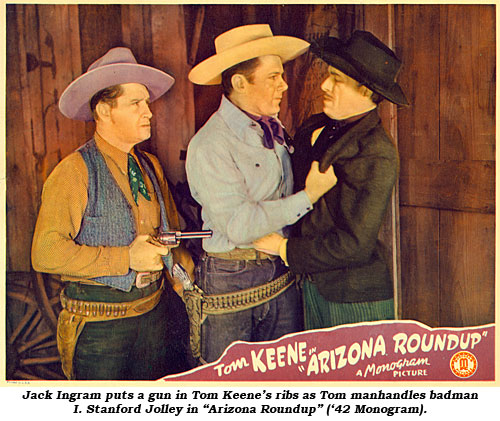
  WHERE TRAILS END (‘42 Monogram) When valley residents are driven from their homes and ranches, U. S. Marshal Keene is dispatched to discover why. Tom helps rancher Steve Clark, his daughter Joan Curtis as well as young Donny Stewart whose father is hung by foreign agent William Vaughn and his cutthroats who are holding surveyor Horace Carpenter hostage. WHERE TRAILS END (‘42 Monogram) When valley residents are driven from their homes and ranches, U. S. Marshal Keene is dispatched to discover why. Tom helps rancher Steve Clark, his daughter Joan Curtis as well as young Donny Stewart whose father is hung by foreign agent William Vaughn and his cutthroats who are holding surveyor Horace Carpenter hostage.
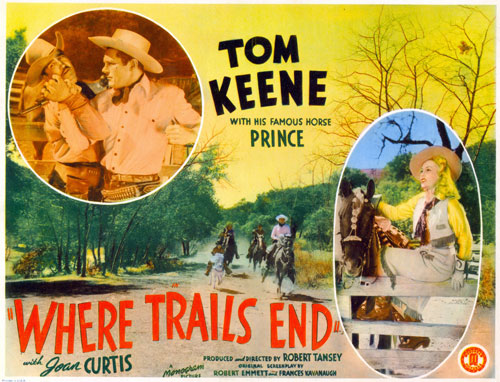
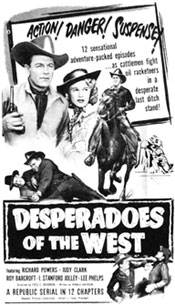    DESPERADOES OF THE WEST (‘50 Republic serial) 12 chapters of non-stop action with the greed for oil the focal point as Keene, now known as Richard Powers, slouchy Lee Phelps, pert Judy Clark and her father, Cliff Clark, head a rancher’s cooperative struggling to bring in their oil wells on time against the specter of crooked oil lease agent I. Stanford Jolley and his hired henchmen bent on securing the property for an Eastern syndicate. Stock from “King of the Royal Mounted” serial (‘41), Allan Lane Red Ryder titles and “Raiders of the Range” (‘42) is neatly incorporated. DESPERADOES OF THE WEST (‘50 Republic serial) 12 chapters of non-stop action with the greed for oil the focal point as Keene, now known as Richard Powers, slouchy Lee Phelps, pert Judy Clark and her father, Cliff Clark, head a rancher’s cooperative struggling to bring in their oil wells on time against the specter of crooked oil lease agent I. Stanford Jolley and his hired henchmen bent on securing the property for an Eastern syndicate. Stock from “King of the Royal Mounted” serial (‘41), Allan Lane Red Ryder titles and “Raiders of the Range” (‘42) is neatly incorporated.
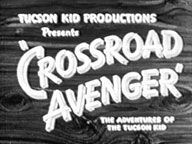  CROSSROAD AVENGER (‘53 Tucson Kid Productions) Keene as two-gun insurance investigator The Tucson Kid brings swift justice to the West. Saloon owner Lyle Talbot tries to frame Keene for the murder of Talbot’s partner. Deputy Tom Tyler (looking pretty haggard) helps Keene. Written and directed by the infamous Ed Wood Jr. (who has a bit scene as a pony express rider). Wood regular Harvey Dunn plays a “comical” prospector who wears his gun where his jock-strap should be. That’s supposed to be humorous. Wood filmed a sequel (“Crossroad Avenger Returns”) to this 25 minute color film. The two were combined in a 50 minute film called “Adventures of the Tucson Kid”. According to Wood, The Tucson Kid was passed up as a TV series in favor of “Wild Bill Hickok” with Guy Madison. Wise move. CROSSROAD AVENGER (‘53 Tucson Kid Productions) Keene as two-gun insurance investigator The Tucson Kid brings swift justice to the West. Saloon owner Lyle Talbot tries to frame Keene for the murder of Talbot’s partner. Deputy Tom Tyler (looking pretty haggard) helps Keene. Written and directed by the infamous Ed Wood Jr. (who has a bit scene as a pony express rider). Wood regular Harvey Dunn plays a “comical” prospector who wears his gun where his jock-strap should be. That’s supposed to be humorous. Wood filmed a sequel (“Crossroad Avenger Returns”) to this 25 minute color film. The two were combined in a 50 minute film called “Adventures of the Tucson Kid”. According to Wood, The Tucson Kid was passed up as a TV series in favor of “Wild Bill Hickok” with Guy Madison. Wise move.
top of page |

